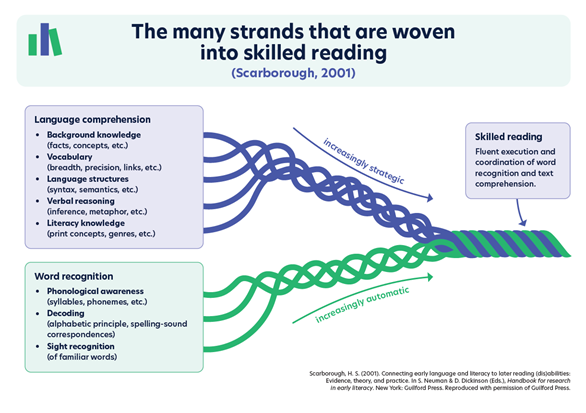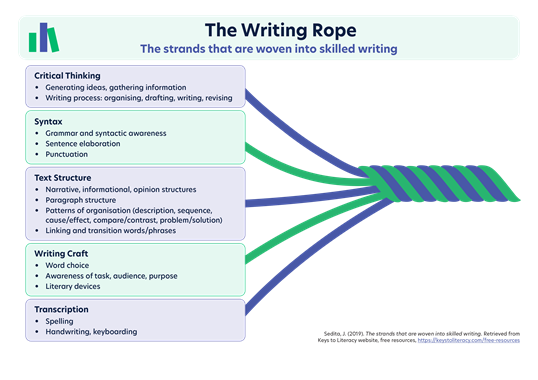Planning resources
Effective planning for literacy involves knowing what to teach and how to teach it.
The Australian Curriculum outlines what to teach. It sets out expectations for the literacy knowledge, concepts and skills that all Australian students need to learn.
For classroom teachers, assessment is key to knowing what your students need to learn. The data you collect from literacy assessments helps to identify students’ strengths and learning needs. This information, along with your curriculum knowledge, guides your planning.
Knowing how to teach the content involves an understanding of evidence-informed teaching approaches. Explore our professional learning topics to find out more.
Planning your literacy program involves:
- using frameworks for literacy planning: knowing the scope of what needs to be taught
- planning your lessons: understanding effective teaching strategies and embedding these within your lessons
- using assessment data: identifying and planning for your students’ literacy strengths and areas of need.

Frameworks for literacy planning
Key literacy frameworks can be used to guide your planning because they outline the skills and knowledge students need to know to become independent readers and writers.
These frameworks provide an overview of what needs to be taught. They are a helpful tool to see the ‘big picture’ of literacy development and to check that you are including all required areas in your literacy program.
- Find out more about frameworks for evidence-informed reading instruction by watching this presentation by Jocelyn Seamer, an expert in systematic reading instruction.
The Australian Curriculum
The Literacy general capabilities in the Australian Curriculum provide a developmental sequence of observable skills across all areas of literacy learning. These can be used as a planning resource to recognise where your students are at and to plan what comes next.
The Big Six of Literacy
The Big Six of Literacy is an evidence-based framework that outlines the six essential areas that contribute to successful literacy development: oral language, phonological awareness, phonics, fluency, vocabulary and comprehension. All six areas need to be planned for in your literacy program.
Each area of the Big Six of Literacy is explained further in the Literacy Hub’s webinar series. The reasons why each component should be included in your literacy program are discussed, as well as practical ways you can do this.
Scarborough’s reading rope model
The reading rope model, developed by psychologist and literacy expert Dr Hollis Scarborough in 2001, is an evidence-informed model that can be used as a framework for planning. It outlines the knowledge and skills required to develop language comprehension and word recognition skills. Students need to be proficient in both areas to become skilled readers.
Plan for word recognition skills (‘bottom of the rope’ skills) by implementing a systematic synthetic phonics (SSP) program within your classroom. This evidence-based approach is the most effective way to teach word recognition skills.
Find out more about teaching word recognition skills by:
- accessing free professional learning about implementing a systematic synthetic phonics approach.
Plan for and explicitly teach language comprehension skills (‘top of the rope’ skills). Learn more about how you can do this by:
- accessing shared reading texts with accompanying teaching activities and information for teachers.
Sedita’s writing rope model
This model, developed by literacy educator Joan Sedita, details the skills and knowledge required for students to become independent writers. It can be used to plan for writing instruction by ensuring all skill areas are covered.
Incorporate the knowledge and skills listed in the model into your literacy planning. In the early years, focus on teaching transcription skills (handwriting and spelling). While students are developing these essential transcription skills, composition skills (critical thinking, syntax, text structure and writing craft) are mainly taught through teacher demonstration and oral composition by students.
Lesson planning
Planning your lessons and building engaging teaching sequences requires an understanding of how to effectively teach the knowledge, concepts and skills students need to become independent readers and writers.
Evidence informs us that there are certain strategies and approaches to literacy instruction that provide the best outcomes for students.
Systematic synthetic phonics
Phonics instruction is an essential part of teaching students to read. Studies have shown that the most effective way to teach phonics is through a systematic synthetic phonics (SSP) approach. This involves systematically teaching letter–sound correspondences, from the simplest to the most complex. Students practise their new learning beginning at the letter-sound level, then word level, sentence level and finally whole-text level.
Find out more about SSP instruction by accessing the Literacy Hub’s:
- free online professional learning on implementing a systematic synthetic phonics approach
- phonics progression, a sequence of letter–sound correspondences and phonic skills for development across Foundation to Year 2.
Use these resources to support your phonics lesson planning:
- Phonological and phonemic awareness lesson activities – this slide pack is a practical resource for use in the classroom and includes teacher scripts and visual slides to support phonological and phonemic awareness instruction.
- Daily review example – this slide pack provides a sample daily review, a key component of teaching phonics following a systematic synthetic phonics (SSP) model.
- Phonics lesson planner example and template – this document provides a template for planning a phonics and spelling lesson, as well as a worked example of a completed lesson.
Explicit instruction
Explicit instruction involves clearly explaining and demonstrating content and skills to your students. It has been found to be an effective way to teach literacy. The following principles summarise explicit instruction.
- Teacher-directed
- Clear learning objectives
- I do, We do, then You do (the gradual release of responsibility framework)
- Spaced reviews
- Small chunks of new content
- Highly interactive
- Routines-based
- Continual monitoring and feedback
When planning lessons and teaching sequences, you can follow an instructional model to ensure that explicit instruction principles are included. This practical phonics instructional model for reading and spelling will help you to plan phonics lessons.
Find out more about implementing explicit instruction in your classroom as part of your literacy practice by accessing:
- free online professional learning about explicit instruction – an instructional model for phonics
- ready-to-use sample phonics lesson slides.
Further Literacy Hub resources to support lesson planning
This set of downloadable texts has accompanying teaching and learning sequences related to the Big Six components of literacy development, and includes student activities, graphic organisers and worksheets.
Assessment
Assessment is integral to planning. The data you collect from assessment tasks will support your understanding of where your students’ strengths and learning needs lie. You can then use this data as a starting point for planning.
The Simple View of Reading model can be used as a framework to plan for reading assessment and to analyse areas of student skills and needs. You can assess beginning readers’ decoding skills (phonics and phonemic awareness) and their language comprehension skills (listening comprehension). As both areas develop, students’ skills in reading comprehension can then be assessed and analysed.
Decoding assessment
Assessment of decoding involves accurate reading of unseen text at the letter, word and whole-text level. When assessing decoding consider:
- the letter–sound correspondences the students have been taught
- the level of word complexity students have the skills for.
Resources to support decoding assessment:
The Year 1 Phonics Check assesses students’ decoding skills across words of increasing complexity. Phonics Check data supports teachers to:
- identify cohort and student-level decoding strengths and instructional needs
- identify student candidates for phonics-based intervention
- track effectiveness of phonics instruction across time
- monitor decoding ability trends across years.
The Literacy Hub progress monitoring tools assess student progress across letter-sound, word-level and sentence-level knowledge and skills for both reading and spelling in line with the Literacy Hub’s phonics progression. They also allow teachers to observe students’ developing fluency across these areas. Fluency is key to forming the bridge between decoding skills and students’ ability to understand what they read.
Language comprehension assessment
Language comprehension assessment involves students demonstrating their understanding of oral language. This can be assessed through structured discussion of texts that are read aloud to them or that they view, and through using oral narrative assessment tools.
CUBED assessment by Language Dynamics Group offers the Narrative Language Measures (NLM): Listening subtest. This free assessment is a useful measure of oral language comprehension, and is suitable from preschool through to Year 2. In the assessment, students listen to and retell a narrative while teachers mark their response against given measures.
Reading comprehension assessment
Reading comprehension assessment involves students demonstrating their understanding of text that they read independently. An appropriate text to use for reading comprehension assessment is a text that the student has:
- the decoding ability to read fluently
- the background knowledge and vocabulary to access the meaning of the text.
The Australasian version of Dynamic Indicators of Basic Early Literacy Skills (DIBELS) has assessments for oral reading fluency and reading comprehension (the Maze assessment).
Further Literacy Hub resources to support assessment
This professional learning module outlines evidence-based approaches to literacy assessment, including how to assess students in individual areas of knowledge and skills and how to use this data to identify students for intervention.

